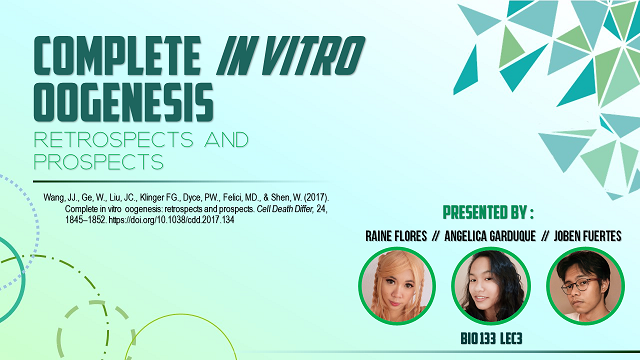Good evening, Janna, and Happy Christmas! Thank you very much for taking the time to view our presentation!
On behalf of our group, I would like to share the common considerations, in terms of ethics, in studying in vitro oogenesis in humans. In this take, let us classify this as in vitro maturation (IVM), in contrast to in vitro fertilization (IVF).
The first thing to take note of, is that if we are to replicate the same system for human oogenesis, it would mean that we would first need a donor of cells. This is a common thing that is discussed in any in vitro procedures. In this case, there are laws that regulate the quantity that is being donated and used, though it varies per country. One sample of this is the guidelines first published by the American Fertility Society back in 1986. This is to ensure that they were not used for any other purposes. As of this moment, I do believe that that is not the only information being made available to the public-- other info like pregnancy rates and such related are put out for transparency (Advena-Redgery et al., 2018). Though, I would say that there are still concerns regarding this due to it being non-specific as to the allowable quantity to be used per procedure.
Anyway, aside from this, we found that there seems to be less published issues on human IVM as there were no standardized protocols in place for it yet in the first place. In fact, results differ from practitioner to practitioner, depending on their expertise, which is probably why it's not gaining as much traction as IVF. But from those few published studies, I would say that the main ethical concern would be on causing possible chromosomal mutations on the resulting embryo born from that artificially structured oocyte. Research show that high rates of abnormalities in chromosomes of rescue IVM embryos were seen (Lan et al., 2019). Taking this into mind, it would be understandable why there is hesitance on further studying this technology.
My final thoughts on this would be, though IVM is a good technology fit for females with Polycystic Ovary Syndrome (PCOS), because they produce a lot of antral follicles which is good for this one, it would be difficult to put this into widespread practice unless a standard protocol, that will also be used to train practitioners, is recognized across the globe. Specific care on the raising of cumulus-oocyte cell complexes must be done to at least reduce risks of failure and other unwanted abnormalities. This means, more research is needed on this field before we can see and raise more concerns in terms of HUMAN subjects.
References ;
Advena-Regnery, B., Dederer, H. G., Enghofer, F., Cantz, T., & Heinemann, T. (2018). Framing the ethical and legal issues of human artificial gametes in research, therapy, and assisted reproduction: A German perspective. Bioethics, 32(5), 314–326. https://doi.org/10.1111/bioe.12433
Lan, V., Ho, T., Gilchrist, R. & Smitz, J. (2019). The Place of In Vitro Maturation in Assisted Reproductive Technology. Fertility & Reproduction, 1, 1-5. https://doi.org/10.1142/S2661318219300022.
